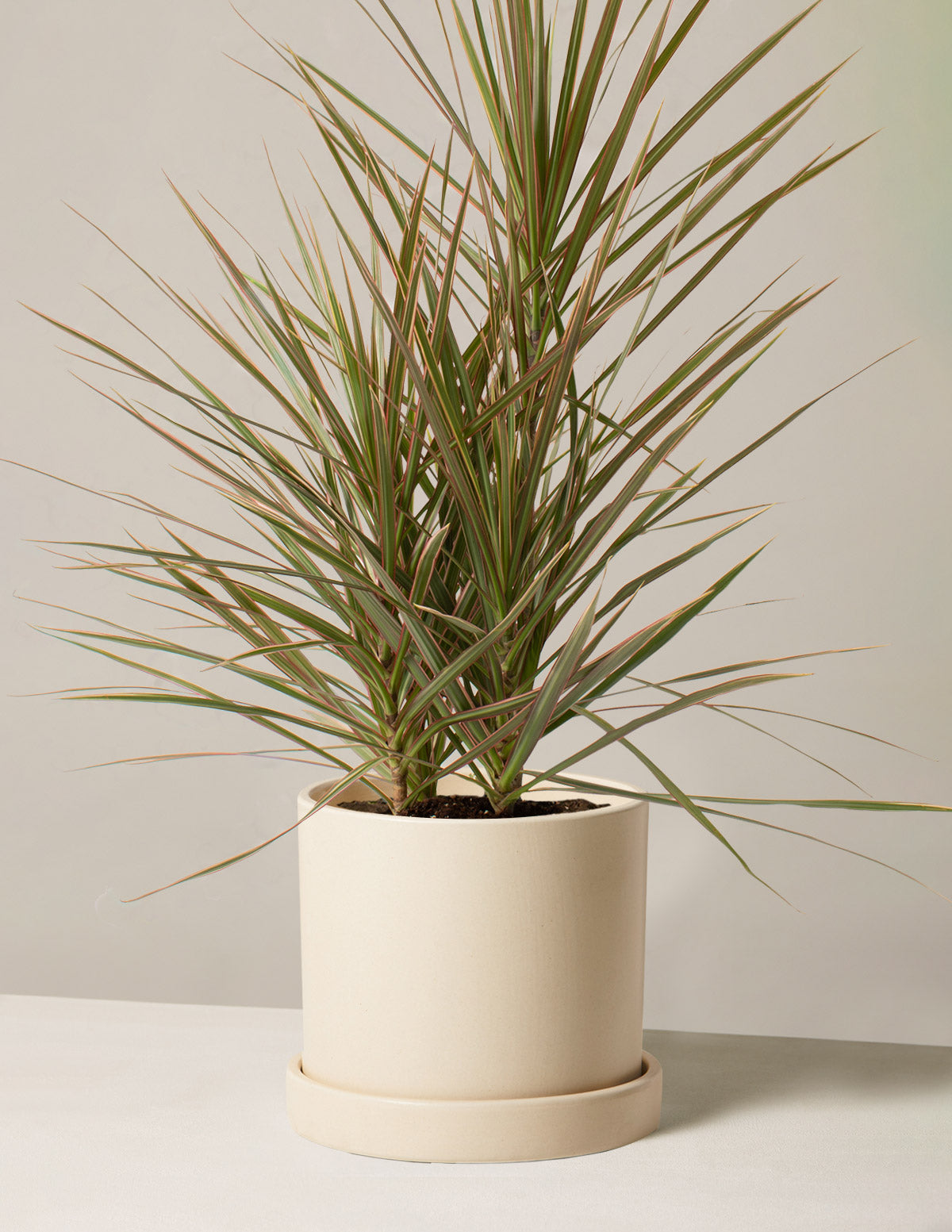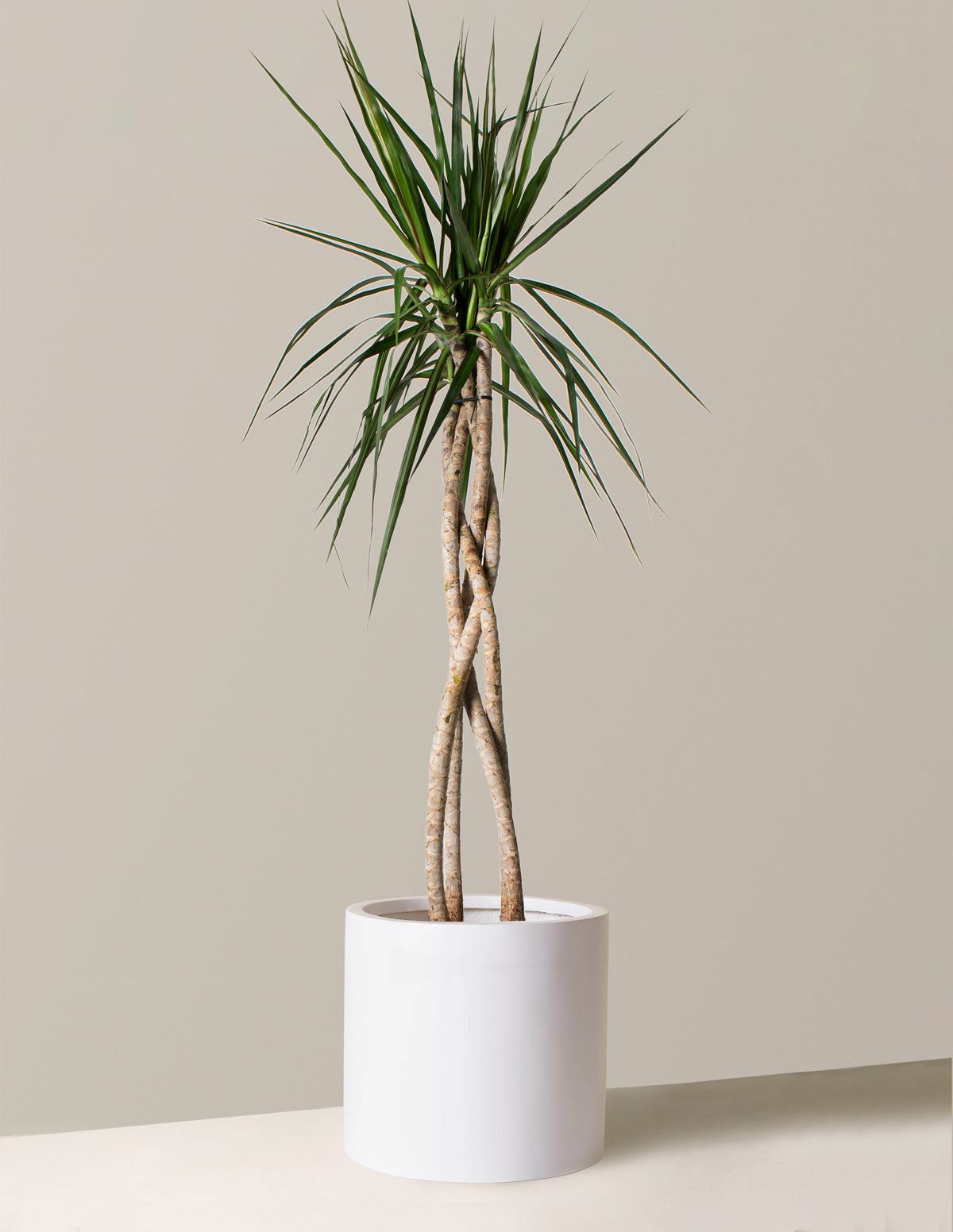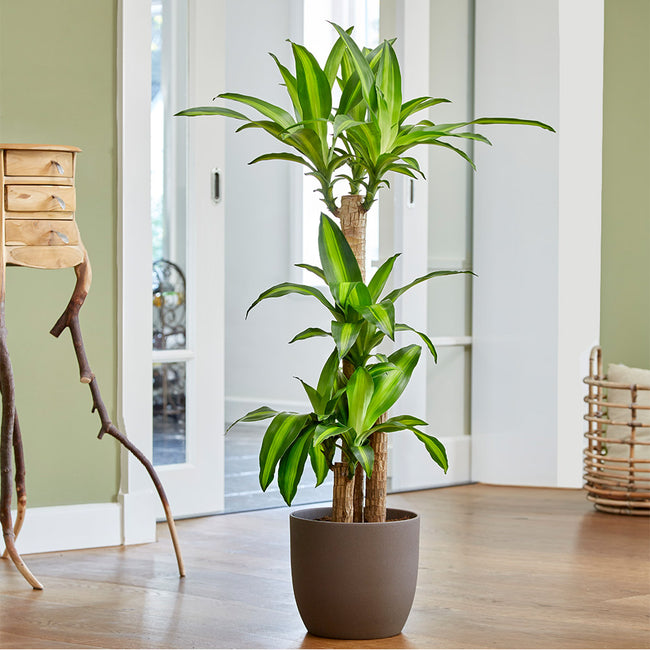
The Dracaena is a sturdy houseplant that is usually sold on a stem, although there are also varieties that are more bushy in shape. Most Dracaenas have long, pointed leaves that end in a point. You can recognize the Dracaena by the stripe that runs along the entire length of the leaf.This plant is fairly easy to take care of. A big advantage is that it does well in a place with some shade. It is also okay if you forget to water it every now and then. Of course the Dracaena remains a living houseplant and still needs a certain amount of care. How you do that, you can read here.
Table of Contents
Dracaena care
Watering Dracaena
An important reason why the Dracaena is so popular: it can easily do without water for a while. So how much water do you give? Just so much that it takes about a week for the soil to dry out again. If this takes longer, then you have watered too much. Do not water again until the soil is completely dry, not before. In terms of care, the Dracaena resembles the Zamioculcas which also needs little water.
The plant also gives signals about the right approach. Is the Dracaena hanging limply? Then you are probably giving it too much water. A first sign of too much water are brown spots and yellow edges on the leaves. Completely yellow leaves can also be a reaction to too much water. If the problem lasts longer you can tell by a limp or soft stem.
Note that yellow leaves and a soft stem are not a reaction to one over-watering. These signs are a sign of root rot, which occurs when the Dracaena stands with its roots in a layer of water for an extended period of time. Prevent this by not overwatering on the one hand, but on the other hand by ensuring that excess water can drain from the pot.
On the other hand, you also get signals when the Dracaena has received too little water. If you don’t water for too long you will see curled leaves. This signal already shows itself when the plant has been standing too dry for a shorter period of time. So: if the leaves curl, then you have not watered your Dracaena for a little too long. It is then time for watering.
Light for the Dracaena
Your Dracaena likes both a lot of light and little light. In general, the darker the location, the darker the leaves. Sanseveria, among others, reacts in the same way to light. A little bit of shadow is allowed, but the Dracaena also needs light to grow well.
If you want to place your Dracaena in the sun, build up the number of hours of sun first. If you do, this plant will do fine in full sun. Does the Dracaena get weak leaves or do the colors fade? Then you have built up the amount of sun too quickly. Very dark leaves and slow growth are a signal for too little light.

Another element to take into account with regard to the location: the dimensions of this houseplant. In the wild, the Dracaena can easily reach 10 meters in height! As a houseplant they do not reach that height, but Dracaenas in pots can still grow quite large.If it really gets too big you can always take cuttings from the Dracaena. You can let the cutting root again. That way, the Dracaena will be small again (and the mother plant can probably be given away).
Temperature
If the temperature is too low, the leaves of the Dracaena will start drooping. Hanging leaves can easily be caused by an air conditioner or an open window (in winter). This problem often occurs with a Dracaena in the bedroom because we often open a window there. Fortunately, the drooping leaves will quickly straighten up again once the problem is corrected.
Too high a temperature from a radiator is also not appreciated by this plant. The reason? It creates very dry air. A short period of time may be fine, but over time you will see dry and brown leaves appear on the Dracaena.
The Dracaena and humidity
So humidity can be a concern in the care of the Dracaena. If the plant is not near a radiator you should not need to take any further steps in this area. Nevertheless, it can be good to do something about the humidity “preventively”. Increasing the humidity has only advantages for this plant, it can do no harm.
First, higher humidity reduces the chance of brown spots on the leaves. In addition, insects, such as lice, have no chance to attach themselves to the leaves. A third reason is that dust also does not (easily) stay on the leaves.
So how do you increase that humidity? Simply by misting the leaves with a plant spray several times a weather. There are other houseplants for which this routine is even more important. These are tropical houseplants such as the Calathea and the Maranta. If you have these plants standing you can include the Dracaena in the routine.
Repot
Repotting the Dracaena is necessary as soon as the old pot has become too small. When this happens depends entirely on the circumstances and care, but normally it is every 2 or 3 years. Often this is not consciously thought about, but repotting can be a heavy intervention for a houseplant. You quickly cause damage to the roots. It is therefore not surprising that this plant loses its leaves after repotting. If the Dracaena loses leaves after repotting, be patient. Under proper care, the plant will sprout again. It is therefore very important that repotting is done in the spring. Then the Dracaena is at full strength and has all the energy it needs to recover from repotting.Finally, always use fresh soil/potting ground when repotting. Then the Dracaena can go on for a while.
The right pot
You are (almost) completely free in your choice of flowerpot for the Dracaena. In practice it comes down to two options:
- You use a plastic inner pot that you put inside the flower pot. This allows excess water to drain through the holes in the inner pot.
- You put the Dracaena directly in the flowerpot, but that flowerpot has holes in the bottom.
So in both cases, water can drain away. This is necessary to prevent root rot. As soon as the Dracaena stands too long in soggy soil, root rot occurs and the plant dies. The first signs are yellow and limp leaves. When you see this, you can usually still save the plant by replacing all the wet soil with dry soil.In addition to holes in the soil, you can further ease drainage by adding hydro grains. A layer of a few centimeters is sufficient.
Plant nutrition for the Dracaena
The most important thing to know about the need for nutrition: rather too much than too little. The Dracaena needs very little plant nutrition. So dilute it well according to instructions on the package. In addition, it is only necessary to add nutrition during the growth period of the plant: from spring until the beginning of autumn.

All Dracaena species fall within the family Asparagaceae (Asparagus family), and more specifically the subfamily Nolinoideae. We often refer to the complete family as Dracaena, but that term is actually only used for the species Dracaena draco. In addition, some common species are:
- Dracaena Compacta
- Dracaena Sanderiana
- Dracaena Surculosa
- Dracaena Janet
- Dracaena Lemon Lime
- Dracaena Marginata
- Dracaena Warneckei
- Dracaena Warneckii
- Dracaena Marginata Bicolor
- Dracaena Burley
- Dracaena White Stripe
Dracaena flowers
The Dracaena falls within the Asparagaceae family. Within this family is also the subfamily that includes the Yucca. If you compare the flowers of these two plants you will understand why. Below is a picture of a Dracaena in bloom.
Buying Dracaena
Where is the best place to buy a Dracaena? This plant is popular, and that is an advantage for buyers. Because of its popularity, the Dracaena is for sale from many suppliers. To compare them properly, it is best to go to a comparison site, such as Bol.com. Via the button below you can immediately compare the complete offer and buy one:
Frequently asked questions and problems
Can the Dracaena be placed outside?
It can, but in principle this houseplant is not suitable for this. If you do want to put the Dracaena outside, do this only during the summer months. Outside the summer it is really too cold. Put it in a place out of the wind. This advice also applies to many other houseplants such as the Grass Lily and the Pancake Plant.
Dracaena leaves fall off
Losing leaves is not always a problem. The Dracaena produces new leaves at the top, the lower ones fall off. This is normal and can be seen with more plants. The Banana plant grows in the same way.
It is also possible that your Dracaena is losing a lot of leaves. Often the loss of many leaves is a stress reaction to something in the environment. This could be repotting or suddenly too cold air. There may also be a slower process at work such as root rot or a constant too low humidity. On this page you can read tips to work on this.
Is the Dracaena air purifying?
Yes: the Dracaena has been found in several studies to be a strong air purifier. Incidentally, this plant is not alone in this. You may also be familiar with the Strelitzia or the Philodendron for their air-purifying effect. These houseplants also have a larger leaf area which ensures that they can purify the air even more than the Dracaena.
Mealybug
Unfortunately, lice, and specifically mealybugs, are a problem we often see with Dracaenas. When you see mealybugs it’s best to act immediately to prevent further spread. Depending on the quantity, you can wipe them off with a cloth. If there are really a lot of them, a (biological) pesticide might be the best option. Also, always check the plants in the immediate vicinity to see if the lice have overrun.
Dracaena summary
| Botanical name | Dracaena |
| Also known as | Dragon blood tree |
| Maximum height natural | 12 meters |
| Maximum height as a houseplant | A few meters |
| Leaf color | Green and colorful, differs by species |
| Family | Asparagaceae (Asparagus family) |
